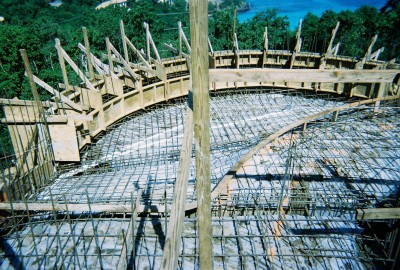The Building Material of Choice
 One of the greatest benefits to reinforced concrete is its structural efficiency. Engineered properly, dollar for dollar, reinforced concrete delivers far superior value when compared to stick framing. This is then realized by the homeowner in a more valuable home – ultimately resulting in a greater return on investment.
One of the greatest benefits to reinforced concrete is its structural efficiency. Engineered properly, dollar for dollar, reinforced concrete delivers far superior value when compared to stick framing. This is then realized by the homeowner in a more valuable home – ultimately resulting in a greater return on investment.
For tropical home building, concrete is the building material of choice. Concrete is not susceptible to termites and it’s the strongest defense against tropical storms and hurricanes. It actually gain strength over time – no other building material can make this claim. Concrete provides peace of mind.
Further peace of mind comes from the fact that concrete doesn’t burn. In the case of a house fire, a concrete home can provide the occupants more time to reach safety.
Once in place, concrete offers significant energy savings over the lifetime of a building. In tropical homes, concrete’s thermal mass affords high R-factors and moderates temperature swings by storing and releasing energy needed for cooling.
Concrete is in tune with the environment. From homes to office buildings to highways, using concrete as a construction material actually helps protect our natural resources and affords unique benefits to consumers. From an environmental standpoint, concrete has a lot to offer.
Concrete is environmentally friendly in a variety of ways. The ingredients of concrete (water, aggregate, and cement) are abundant in supply and take a lesser toll in their extraction than other construction materials such as wood and steel. Quarries, the primary source of raw materials, can be reclaimed for recreational, residential, or commercial use. Or they can be restored to their natural state.
As a nearly inert material, concrete is an ideal medium for recycling waste or industrial byproducts. Many materials that would end up in landfills can be used instead to make concrete. Blast furnace slag, recycled polystyrene, and fly ash are among materials that can be included in the recipe for concrete and further enhance its appeal. Waste products such as scrap tires and kiln dust are used to fuel the manufacture of cement. Even old concrete itself can be reborn as aggregate for new concrete mixtures.
Another environmental plus for concrete is energy efficiency. From manufacture to transport to construction, concrete is modest in its energy needs and generous in its payback. The only energy intensive demand is in the manufacture of portland cement, typically a 10-15% component of concrete. Since the materials for concrete are readily available, concrete products and ready-mixed concrete can be made from local resources and processed near a job site. In our island environment there is a lower carbon footprint for transportation compared to any type of wood or steel.
Further commendable characteristics of concrete are waste minimization and long life. Whether cast-in-place or pre-cast, concrete is used on an as-needed basis with virtually no waste. Concrete’s legendary durability conserves resources by reducing maintenance and the need for reconstruction.
For centuries, Concrete has been the most reliable and versatile building material. Concrete paves the way toward an environmentally secure future for successive generations here on Earth.








